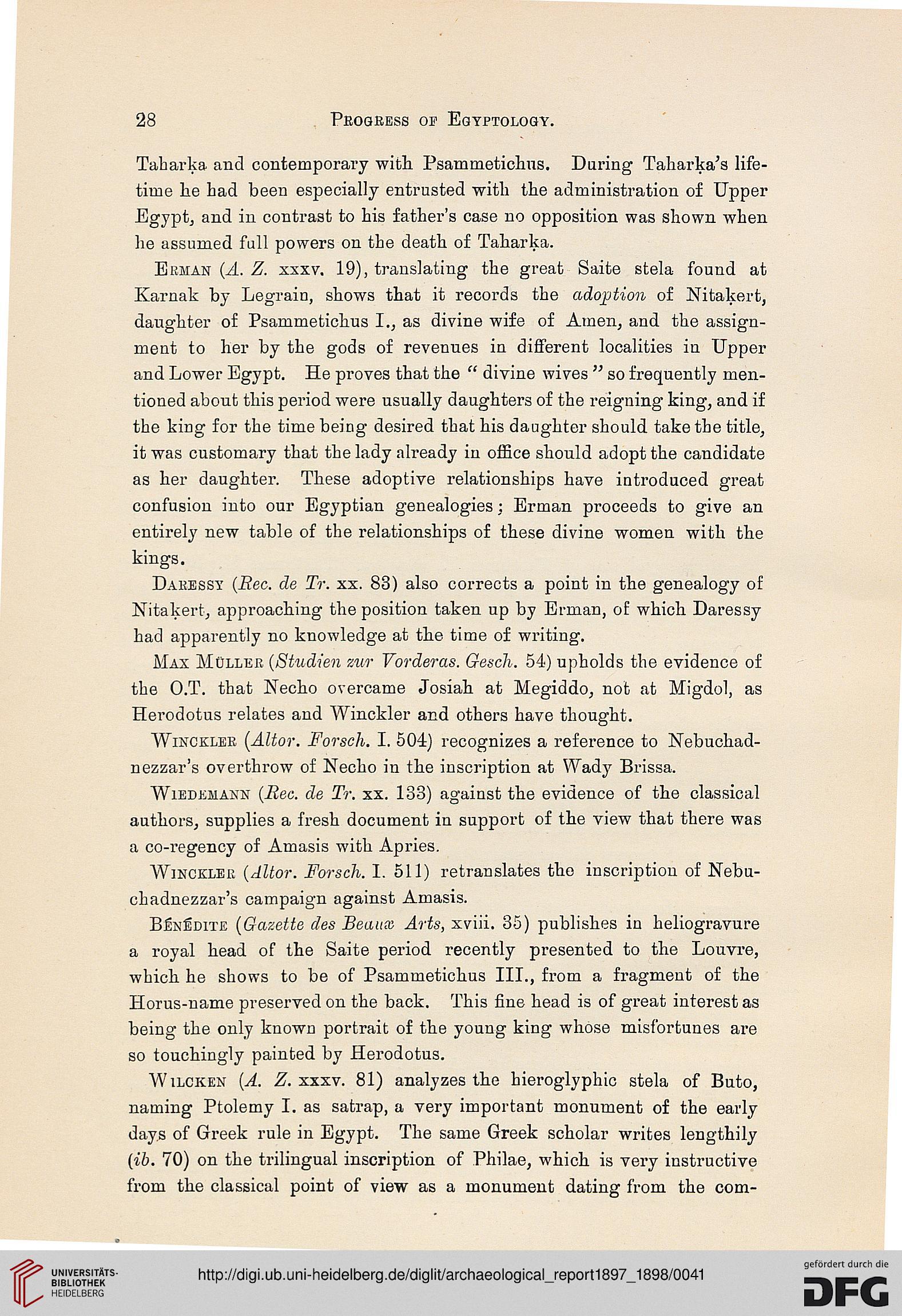28
Progress op Egyptology.
Taharka and contemporary with Psammetichus. During Taharka's life-
time he had been especially entrusted with the administration of Upper
Egyptj and in contrast to his father's case no opposition was shown when
he assumed full powers on the death of Taharka.
Ekman (A. Z. xxxv. 19), translating the great Saite stela found at
Karnak by Legrain, shows that it records the adoption of Nitakert,
daughter of Psammetichus I., as divine wife of Amen, and the assign-
ment to her by the gods of revenues in different localities in Upper
and Lower Egypt. He proves that the " divine wives " so frequently men-
tioned about this period were usually daughters of the reigning king, and if
the king for the time being desired that his daughter should take the title,
it was customary that the lady already in office should adopt the candidate
as her daughter. These adoptive relationships have introduced great
confusion into our Egyptian genealogies : Erman proceeds to give an
entirely new table of the relationships of these divine women with the
kings.
Dakbssy (Bee. de Tr. xx. 83) also corrects a point in the genealogy of
Nitakert, approaching the position taken up by Erman, of which Daressy
had apparently no knowledge at the time of writing.
Max Muller (Studien zur Vorderas. Gesch. 54) upholds the evidence of
the O.T. that Necho overcame Josiah at Megiddo, not at Migdol, as
Herodotus relates and Winckler and others have thought.
Winckler (Altor. Forsch. I. 504) recognizes a reference to Nebuchad-
nezzar's overthrow of Necho in the inscription at Wady Brissa.
Wiedemann (Bee. de Tr. xx. 183) against the evidence of the classical
authors, supplies a fresh document in support of the view that there was
a co-regency of Amasis with Apries.
Winckler (Altor. Forsch. I. 511) retranslates the inscription of Nebu-
chadnezzar's campaign against Amasis.
Benedite (Gazette des Beaux Arts, xviii. 35) publishes in heliogravure
a royal head of the Saite period recently presented to the Louvre,
which he shows to be of Psammetichus III., from a fragment of the
Horus-name preserved on the back. This fine head is of great interest as
being the only known portrait of the young king whose misfortunes are
so touchingly painted by Herodotus.
Wilcken (A. Z. xxxv. 81) analyzes the hieroglyphic stela of Buto,
naming Ptolemy I. as satrap, a very important monument of the early
days of Greek rule in Egypt. The same Greek scholar writes lengthily
(ib. 70) on the trilingual inscription of Philae, which is very instructive
from the classical point of view as a monument dating from the com-
Progress op Egyptology.
Taharka and contemporary with Psammetichus. During Taharka's life-
time he had been especially entrusted with the administration of Upper
Egyptj and in contrast to his father's case no opposition was shown when
he assumed full powers on the death of Taharka.
Ekman (A. Z. xxxv. 19), translating the great Saite stela found at
Karnak by Legrain, shows that it records the adoption of Nitakert,
daughter of Psammetichus I., as divine wife of Amen, and the assign-
ment to her by the gods of revenues in different localities in Upper
and Lower Egypt. He proves that the " divine wives " so frequently men-
tioned about this period were usually daughters of the reigning king, and if
the king for the time being desired that his daughter should take the title,
it was customary that the lady already in office should adopt the candidate
as her daughter. These adoptive relationships have introduced great
confusion into our Egyptian genealogies : Erman proceeds to give an
entirely new table of the relationships of these divine women with the
kings.
Dakbssy (Bee. de Tr. xx. 83) also corrects a point in the genealogy of
Nitakert, approaching the position taken up by Erman, of which Daressy
had apparently no knowledge at the time of writing.
Max Muller (Studien zur Vorderas. Gesch. 54) upholds the evidence of
the O.T. that Necho overcame Josiah at Megiddo, not at Migdol, as
Herodotus relates and Winckler and others have thought.
Winckler (Altor. Forsch. I. 504) recognizes a reference to Nebuchad-
nezzar's overthrow of Necho in the inscription at Wady Brissa.
Wiedemann (Bee. de Tr. xx. 183) against the evidence of the classical
authors, supplies a fresh document in support of the view that there was
a co-regency of Amasis with Apries.
Winckler (Altor. Forsch. I. 511) retranslates the inscription of Nebu-
chadnezzar's campaign against Amasis.
Benedite (Gazette des Beaux Arts, xviii. 35) publishes in heliogravure
a royal head of the Saite period recently presented to the Louvre,
which he shows to be of Psammetichus III., from a fragment of the
Horus-name preserved on the back. This fine head is of great interest as
being the only known portrait of the young king whose misfortunes are
so touchingly painted by Herodotus.
Wilcken (A. Z. xxxv. 81) analyzes the hieroglyphic stela of Buto,
naming Ptolemy I. as satrap, a very important monument of the early
days of Greek rule in Egypt. The same Greek scholar writes lengthily
(ib. 70) on the trilingual inscription of Philae, which is very instructive
from the classical point of view as a monument dating from the com-





